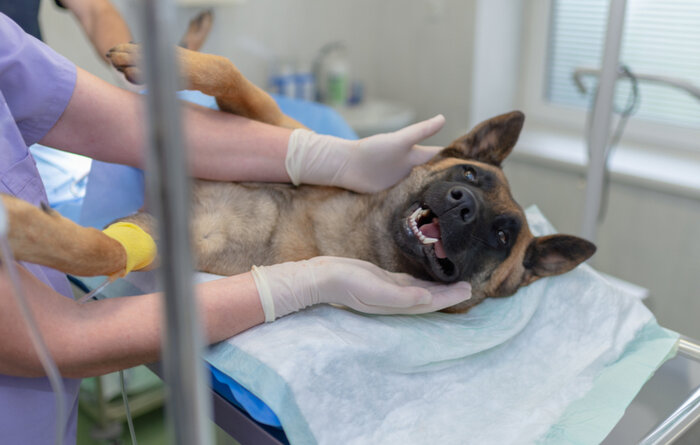A BetterVet Expert Weighs In
Most of us remember Bob Barker reminding us to neuter our pet at the end of “The Price is Right” and, most of us heeded his sage advice and dutifully had our pets altered.
If we asked Bob when to neuter a dog, he surely would have said, “talk to your vet!” The thought from then up until recently was to have the surgery performed before the first heat cycle.
In recent years, however, compelling data have emerged, showing the benefits of neutering a dog, when to spay a dog, and why we should generally wait for the right age to neuter dogs...our world-class veterinarian from BetterVet, Dr. Rensema with our Eugene, OR practice shares some insight below.
But before we get into that, we’ve recently partnered with the company, BetterVet. BetterVet is a comprehensive digital veterinary service that performs virtual and in-home care for your pet.
From check-ups, nutrition, to dental surgery and vaccination, BetterVet has you covered. BetterVet is the veterinary care of today’s digital landscape as well as the future.
No more scheduling visits weeks out in advance, they are able to provide veterinary service in a timely and urgent matter if necessary. Check out their app today and sign up today!
Benefits of Spaying/ Neutering a Dog
The first question you may ask yourself is what are the benefits of spaying a dog or neutering your pet? Dr. Renesma weighs in:
- Prevent disease – Spaying/neutering a dog absolutely decreases or prevents the risks of certain cancers (mammary, uterine, and testicular) as well as life-threatening reproductive infections (pyometra) in females while reducing the risk of certain urinary diseases in males (benign prostatic hyperplasia aka BPH).
- Alter behavior – Altering sex can absolutely reduce dog-on-dog aggression and marking behaviors. In cats, spaying or neutering can not only reduce marking it can also significantly reduce the fights and abscesses that follow. Neutering can even potentially reduce other sex-linked mounting behaviors as well.
- Convenience – Many owners are not equipped to deal with the bleeding, whining, yowling, and roaming behaviors an animal in heat or otherwise left intact may exhibit.
- Population control – While this may not pertain to domesticated pets, neutering/spaying a dog is vitally important in communities that have feral/stray populations.
Throughout the past decade, veterinarians around the world have been gathering data regarding the health of pets.
For example, one study examined a large population of Golden Retrievers throughout their lifetimes.
It considered how diet, age of neuter/spay, and other factors influence various medical conditions.
So, When to Neuter a Dog?
Data shows that, for Golden Retrievers, we need to wait at least until sexual maturity (usually after first heat or around 1 year of age) before deciding to spay or neuter, if we decide to spay/neuter at all!
Other breeds (Labrador Retrievers, German Shepherd dogs, Rottweilers, Doberman Pinschers, among others) have shown compelling reasons to wait significantly longer before spaying or neutering due to their increased risks of cancers and other medical issues.
Be sure to consult your veterinarian to determine when to spay a dog and the appropriate window of opportunity (“sweet spot”) in which to spay or neuter your pet.
Risks of Neutering a Dog
Though the consensus is that spaying/neutering is recommended for domesticated non-breeding pets, there are some risks associated with the procedures.
- Urinary Incontinence – In many large breed dogs, spaying prior to 6 months of age can increase urinary incontinence incidence by up to 20%. Waiting a year or longer can decrease this risk significantly.
- Joint Disease – In many dogs (males and females), spaying or neutering at an early age increases their risk of various joint diseases, especially if done earlier than 6 months of age. Waiting for the appropriate age when to neuter a puppy can decrease this risk.
- Increased Cancer Risk – While spaying or neutering can reduce the risk of certain cancers (see above), it can increase the risk of other cancers (bone cancer, lymphoma, and cancers of the circulatory system) depending on the timing.
- Behavior Changes – A few studies have shown that spaying or neutering can be linked to an increase in the development of anxiety in certain dog breeds.
But, What is Neutering a Dog?
Neutering is the process of removing the testicles of male dogs to sterilize and make them infertile. The testicles refer to the two oval-shaped sexual glands located at the scrotum or the loose sac near your dog’s bottom.
Testicles are the organs that produce the testosterone hormones, sperm, and other secretions that play a huge role in reproduction.
So by neutering or castrating a male dog, you can stop its reproduction ability. It is only legally performed at a veterinary clinic.
How to neuter a dog?
Before the procedure, the vet usually will have to examine your pet and perform a pre-anesthetic blood test to determine how your dog should be given the anesthesia.
Your dog will then be anesthetized if acceptable and the vet will place a breathing tube to your pet’s trachea to deliver oxygen and gas anesthetic to its lungs.
Then your vet will make an incision in front of the male dog’s scrotum and cut the stalk of its testicles.
And lastly, he will remove the testicles through the incision and close the wound with absorbable internal sutures.
What is Spaying a Dog?
Spaying is the common term for ovariohysterectomy. It is a surgical procedure performed to remove the reproductive organs of a female dog, specifically, the ovaries and uterus.
The purpose of spaying is to sterilize your dog and eliminate her heat cycle to prevent her from reproducing.
These days, some vets are now performing ovariectomies where they only remove the ovaries. It’s a different technique but has the same purpose as the ovariohysterectomy.
Are female dogs spayed or neutered?
Spaying refers to the process of removing the female dog’s reproductive organs, while neutering is the procedure performed for males.
And as we mentioned earlier, the ovaries and uterus are removed in this type of procedure, leaving your female pooch unable to conceive or reproduce.
How much does it cost to spay a dog?
The cost of spaying a dog ranges from $150 to $240, depending on your dog’s weight and the complexity of the procedure. Some low-cost clinics have lower pricing, but regular vet usually charges more.
It’s also worth noting that spaying a dog costs more than neutering because this process is more complicated than the latter.
How to spay a dog?
Similar to the neutering process, your female dog will need to undergo a thorough examination and pre-anesthetic blood tests to determine if it’s safe to anesthetize your pet.
If possible your vet will place an intravenous catheter to provide anesthesia and offer fluid therapy during the surgery.
And after placing the breathing tube in your dog’s trachea, your vet will then start the surgery.
The surgery involves making an incision below the belly button or umbilicus of the pet and removing both the ovaries and uterus or just the ovaries, depending on your vet’s technique.
Then, the vet will close the wound using absorbable sutures; stitches that are made out of materials that can be absorbed by the body over time. It’s safe and gets rid of the need to return to the vet for suture removal.
When to Neuter/Spay Your Dog: Questions You May Ask Yourself
Wow, this is a lot to take in! How do I make a decision?
Luckily, you have time to make this important decision.
Most studies are pointing to waiting 6-12 months before altering your pet.
You have plenty of time to discuss this with your veterinarian.
They can give you the best and most current advice about when to neuter a male dog and why neuter a pet while taking into account your and your pets’ individual needs, lifestyle, breed, and/or genetic predispositions to make the best-informed decision.
But I got my pet from a shelter and they are already spayed/neutered! Isn’t this too early?
No, the veterinarian at the shelter understands all of the factors listed above but their mission is to prevent animal suffering by preventing overpopulation.
Thus, they need to capture the opportunity to alter the animals in their care while they can.
What about my cat/rabbit/guinea pig/snake/etc?
Great question! In general, we see fewer complications with an early spay or neuter in cats.
Data supports neutering cats at or before 5 ½ months.
For rabbits, their incidence of reproductive cancer is very high so spaying/neutering is recommended at a young age.
However, you should discuss timing with your veterinarian.
For other species, we generally keep them intact unless there are major issues. Again, discuss this with your veterinarian.
When to Neuter or Spay Your Dog: Take Home Message
Discuss this important decision with your veterinarian. Don’t be surprised if they counsel waiting 6-12 months or even longer to alter your pet.
Just know that considering the risk factors when deciding when to neuter a dog can help to ensure that you and your pet have a long, healthy, and happy life together.
References
Hart, Benjamin L., et al. “Assisting Decision-Making on Age of Neutering for 35 Breeds of Dogs: Associated Joint Disorders, Cancers, and Urinary Incontinence.” Frontiers in Veterinary Science, vol. 7, 2020, https://doi.org/10.3389/fvets.2020.00388.
Hart, Benjamin L., et al. “Neutering of German Shepherd Dogs: Associated Joint Disorders, Cancers and Urinary Incontinence.” Veterinary Medicine and Science, vol. 2, no. 3, 2016, pp. 191–199., https://doi.org/10.1002/vms3.34.
Kent, Michael S., et al. “Association of Cancer-Related Mortality, Age and Gonadectomy in Golden Retriever Dogs at a Veterinary Academic Center (1989-2016).” PLOS ONE, vol. 13, no. 2, 2018, https://doi.org/10.1371/journal.pone.0192578.
Urfer, Silvan R., and Matt Kaeberlein. “Desexing Dogs: A Review of the Current Literature.” Animals, vol. 9, no. 12, 2019, p. 1086., https://doi.org/10.3390/ani9121086.
Related









cytotec online https://cytotec.icu/ cytotec pills buy online
ed meds online without doctor prescription https://edwithoutdoctorprescription.pro/ buy prescription drugs without doctor